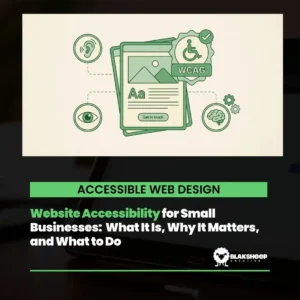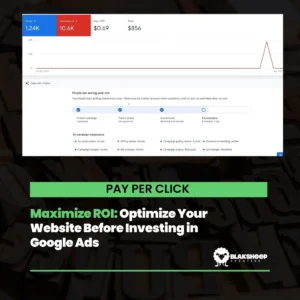Why you shouldn’t let just let anyone build your website.
Everyone has a friend or family member who knows a little about computers.
If they can fix your email, they must be able to design a good website, right?
On occasion, we’ll lose a potential customer who is reluctant to invest in the expense of having a professional design and develop their website.
We realize that having a custom website isn’t cheap. Even though we try to make our small business websites and SEO affordable, those “Build a Website in 10 minutes.” commercials make it so easy.
Sure, anyone can hop on Wix or other free website builders like Duda and toss together a website in minutes. But what if we told you WIX is horrible for a business website?
But, as they say, “You get what you pay for.”
Your DIY website could do more harm than good if your volunteer web designer doesn’t focus on a few essential items.
Feel free to make your own choice, but here are a few things you should consider before letting anyone create your website.
Usability: It’s all about your website’s end-user.

Is your website designer familiar with your target market? When selecting (what’s usually a stock theme), is it based on your prospective customers and how they will use your website?
Navigation
Planning your website’s navigation elements is vital. A professional developer will help you employ a basic sitemap with your site’s vital pages in the main menu.
Your typical website visitor will likely leave and move on to your competition if you have ten pages in your site navigation bar.
Necessary Elements
Your site’s functionality is also a leading factor in whether or not your website converts visitors to leads.
Does your DIY designer know how to optimize landing pages for conversions?
These functionality elements are absolutely necessary:
- A well-arranged and user-friendly sitemap and site architecture.
- Clear and concise navigation labels.
- An easily distinguishable path to get in touch with you.
- Font size, spacing, and contrast make your content easy to read.
Proper planning will make for a better user experience. If your website’s visitors have to think to find the information they are looking for, they won’t stick around.
And, there goes a potential customer.
Results: Motivate Your Visitors to Take Action
This is perhaps the #1 issue we see with amateur and DIY websites.
Someone put your website together and included lots of details.
They made it look decent and assumed that many words and a so-so design would bring in leads.
The problem: They developed your website as a sales brochure, not as an advertising and marketing tool. That’ll cost you money.
Q3. What is a common mistake that DIY website builders sometimes make? #BHChat
— Bluehost (@bluehost) August 27, 2019
Make sure your website does what you need it to. Read about the main purpose of a website.
We haven’t even discussed SEO so far. Search Engine Optimization is outside this article’s scope, and we could certainly talk about it all day. We suggest you read about why SEO is vital to your website’s success.
For a website to help your business gain leads online, it needs a call to action. You need to persuade your visitors to take a particular action and make it easy for them to do so.
Most of the time, when a visitor lands on your website, they are looking for a solution to a problem.
- Maybe they need your services.
- Perhaps they want to contribute to your cause.
- Maybe they want to learn more about a topic.
You’ve got to make it easy to find what they’re looking for.
- Show them how to get in touch with you.
- Tell them how to donate to your organization.
- Help them read articles on your site.
Don’t hesitate to add CTAs to your website. People like things to be spelled out for them, so show them exactly how to find what they’re looking for.
Call to Action (CTA) examples:
- Call today.
- Get in touch with us now.
- Download our e-book.
- Register for our webinar.
- Set up a trip.
- Schedule a free appointment.
- Register now
- Book us now.
Your website’s CTAs should be planned in advance with your web developer and should be based on your sales process and how to convert your visitors into customers.
It should be designed to motivate calls or clicks.
If your DIY designer doesn’t include a call to action, then you had might as well not even have a website.
Security: Keep Your Visitors and their Information Safe

Your free family website builder is most likely more focused on making your website look pretty more than keeping it safe and secure.
Unfortunately, this can cause significant issues down the line.
Protip: In our experience, we’ve had to clean up far too many WordPress sites for customers whose “developer” left the default ‘admin” username. This is a major mistake, and internet professionals and hackers alike know it.
Never use ‘admin’ for your WordPress username.
Next, outdated plugins, themes, and installations are additional safety threats.
Will your volunteer designer maintain your website after you launch it?
Will your volunteer designer teach you how to do it?
Quick WordPress Safety Suggestions:
- If your WordPress username is ‘admin,’ change it.
- Back up your website regularly. Most managed hosts will do that for you.
- Update your plugins and themes regularly.
Don’t forget to update your PHP version. Read our newest blog post to learn why/how/and when you should make this update.
Future Updates: Will Your Volunteer Vanish?

Do you know the leading reason BlakSheep creative gets to save the day?
Wanna-be web designers and developers always seem to disappear.
That uncle in IT that designed a business’s website moves on to another hobby, and the site owner has no idea how to access their website.
Granted, their DIY builder created an excellent-looking website but he hasn’t looked back since.
Most hobbyist website designers build a site and think that their work is complete.
You have to maintain your website correctly. Here are five maintenance tips.
Five website maintenance tips:
- Learn how to make changes to your site yourself.
- Have access to your domain registrar and make sure it remains in your name.
- Have the login and password for your hosting account.
- Have the login and password for your WordPress admin panel.
- Update your website regularly.
We provide maintenance plans for businesses so that they can focus on their business activities. Plus, we work on websites daily; we can make changes anytime.
So, is it worth having your nephew’s friend build you a low-cost website?
It may be lower in cost than a professionally created and maintained website, but it will probably cause aggravated customers, decreased sales leads, hacker attacks, and outdated design.
A well-thought-out, properly maintained website will undoubtedly bring you more visits, more sales, and more success.
Consider your website as a financial investment for your business.
Don’t base your decision solely on cost.
Call us today or complete the form below to see how you can benefit from a professionally designed website.
The choice is yours.



